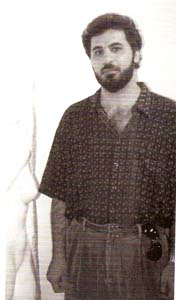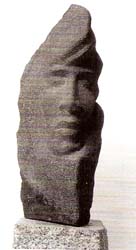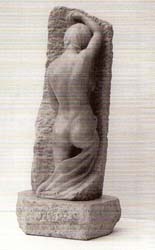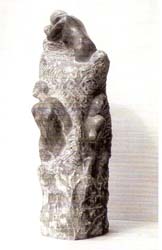Who are you? I grew up in Nasria, Iraq, the third in a family of 11 children. I had an uncle who used to do small drawings and oil paintings. When I was three or four I was fascinated. In school I drew a lot and had a grade school teacher who exposed us to fine art. A friend gave me a book of Michelangelo’s work on the Sistine Chapel and I copied the drawings many times, but though I loved art, I had not considered becoming an artist until I met a friend who was attending one of the four National Art Institutes. In Iraq, the schooling is free if you can gain acceptance. My friend encouraged me and started teaching me about watercolor, drawing, and working with light and shadow.

Why did you become an artist? I am an artist because I can’t imagine not being one.
What key life experiences affected your direction in art? By the time I was in 9th grade I had enough knowledge and practice to get accepted by the Art Institute of Basra, where I lived and studied for 6 years. At the Institute the focus was on classical art and building a strong foundation in the basics. At the time I felt reigned in and hated it, but I really appreciate the benefits of that type of education now.
The Gulf war and the failed Iraqi revolution that followed it brought a range of experiences and emotions that I have expressed in my work. I think that brings a deeper perspective to my art and at the same time art gives me a release for the feelings those memories bring.
Who or what has influenced your art form? The works of Rodin, Bernini, and Michelangelo have had a huge effect on my concept of art. They have set the direction I strive toward. I was also inspired by the photo in a NWSSA newsletter of a beautiful piece by Bruce. Hoheb from Portland. He passed away shortly after I saw it and I was never able to meet him or see other work of his, but I still look at the photo of his “Back Study” and feel both moved and inspired.
Why is art important to you? I don’t really know why art is important to me; I only know that I need it.
How does your art reflect your life philosophy? What is your life philosophy? I find that art renders everything profound and beautiful. If you can look at positive as well as negative experiences as something that defines life and character, if you can look for the lesson in everything, then life itself can be a wonderful work in progress.
What is your relationship to NWSSA? Since I first began to study art, I have found the company of other artists to be warm, helpful, inspirational, and rewarding. Meeting Boris Spivak, and through him joining the NWSSA, has had a profound effect on my art form. I learned so much and received so much encouragement and support from the people in the Association that stone sculpture has become my primary passion in art.
What kind of art do you create? My sculpture is mostly realistic and figurative.
How do you get your ideas? Due to my fascination with the human figure, I often observe physical bearing that communicates something I want to express in sculpture. When I have a predetermined idea of what I want to create, working with block stone can offer more freedom for the project, but I usually prefer to work with rough stone because it is suggestive; I look at the stone and try to see a form inside.
How do you develop your ideas? I most often do direct carving though I sometimes make several sketches. If I’m working on a commissioned piece I make sketches first and then develop a maquette.
What is the source of inspiration of your form, language or imagery? I enjoy mythology, especially Greek and Roman; the gods express so many human foibles and attributes and the stories are beautiful. Much of the sculpture I’ve done was inspired by those myths.
What are you trying to express? I try to express the human condition and its tremendous range of spirit.
Describe a recent piece or two. I’ve been happy with a couple of recent pieces. One is called “Persephone’s Descent?.” It is a 28” tall sandstone sculpture. Hades, the god of the underworld, carried Persephone off to be his consort, causing her mother Demeter, the goddess of grain, to allow the earth to grow barren out of grief. Because of her mother’s grief, Zeus permitted Persephone to spend six months of the year in the house of Hades and six in the light of day.
The other piece is one I started at the Whidbey Island Retreat. It’s called “Icarus,” made of alabaster, and is about half life-size. It portrays Icarus after the fall.
What do you like about them? I like the drama of both these stories, the speculation. What do they feel? How is that emotion expressed by their bodies? Is Persephone conflicted? Has Icarus given up?
What is the major theme or intent in your art? Humanity.
Are you working part-time or full-time on your art? Full-time.
What stones do you prefer to carve? Why? Marble is definitely my favorite stone, but I also enjoy working with granite and basalt. I prefer working with hard stone because of the durability, and of course, marble is the classic stone for sculpture.
What scale or size do you work in? Which scale do you prefer? I’ve worked with different scales from 10” pieces to life-size ones. Life-size is definitely what I prefer.
What is your working process (do you have several pieces going at once or just one)? At home I have a very small area that I use to carve small pieces up to 300 lbs. I also use Vic Picou’s studio when I work on large pieces and especially when I have to use pneumatic tools with the hard stone such as granite and basalt. I like to work with one piece at a time, although sometimes I have a couple of pieces going on at the same time.
What tools do you primarily use? It depends on the stone, but I do use hand, electric, and air tools. The angle grinder is my favorite tool because I can remove more stone quickly and there is not a lot of force going into the stone that sometimes could weaken it.

Where do you exhibit your work? There are two galleries, one in Kirkland and the other in Tacoma, that have a few pieces of my work. The city of Puyallup has a beautiful program called “Arts Downtown.” They invite sculptors to display their work in the city for one year; this is the third year I’ve participated. Kirkland has a similar program and I have one of my pieces there. I really like these types of programs because they give the artists great exposure for their art and an opportunity for public art commissions. I also have a website and I really appreciate the positive comments and the invitations to the international shows and competitions.
How much work do you complete in a year? I probably do about 10-15 pieces a year.
Do you teach your art form? I have taught at the Camp Brotherhood Symposium for the last three years. I’m also planning to give a couple of workshops next year if I can find a studio with enough room for 5-8 students.
What have been your satisfactions in life as an artist? What have been your obstacles and challenges? I get immense satisfaction every time I finish a piece. Teaching has also been a good experience for me. The first year I taught I was nervous about my English, but everyone seemed to understand me just fine. Finding a place to work has presented some difficulties as well; stone carving is much too noisy for my son, so most of my work cannot be done at home.
What are you looking forward to? My dream is to have a large studio, preferably at home. I’d also like to go to Italy someday to see the works of Michelangelo and Bernini.


